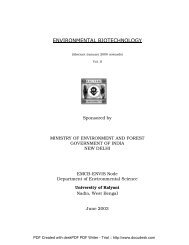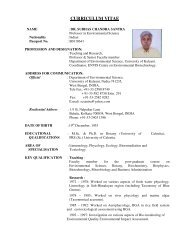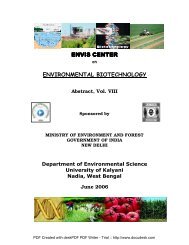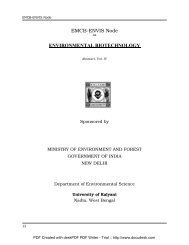EMCB-ENVIS Node ENVIRONMENTAL BIOTECHNOLOGY
EMCB-ENVIS Node ENVIRONMENTAL BIOTECHNOLOGY
EMCB-ENVIS Node ENVIRONMENTAL BIOTECHNOLOGY
You also want an ePaper? Increase the reach of your titles
YUMPU automatically turns print PDFs into web optimized ePapers that Google loves.
<strong>EMCB</strong>-<strong>ENVIS</strong> Centre<br />
(0.19 g nonylphenol kg-1 soil). Nonylphenol was always completely removed from the leachates<br />
of the two soils. It was removed by 99% from the artificial soil but only 62% from real<br />
contaminated soil after 18 and 20 d of treatment, respectively, showing limitation due to<br />
nonylphenol adsorption.<br />
Ana Soares, Benoit Guieysse, Osvaldo Delgado, Bo Mattiasson. (Biotechnology Department,<br />
Lund University, P.O. Box 124, S-221 00 Lund, Sweden). Aerobic biodegradation of<br />
nonylphenol by cold-adapted bacteria. Biotechnology Letters, 25(9) (2003), 731-738.<br />
Three strains capable of mineralizing nonylphenol as sole carbon source were isolated from a<br />
sample of contaminated soil and characterized as two Pseudomonas spp. and a<br />
Stenotrophomonas sp. The two Pseudomonas spp. expressed characteristics typical of<br />
psychrophiles growing optimally of 10 °C and capable of growing at 0 °C. The<br />
Stenotrophomonas sp. was more likely psychrotrophic because it had an optimal temperature<br />
between 14 and 22 °C although it was not capable of growing at 4 °C. At 14 °C, one of the<br />
Pseudomonas spp. exhibited the highest rate of degradation of nonylphenol (4.4 mg l -1 d -1 ), when<br />
compared with axenic or mixed cultures of the isolates. This study represents, to the best of our<br />
knowledge, the first reported case of cold-adapted microorganisms capable of mineralizing<br />
nonylphenol.<br />
Ana Soares, Benoit Guieysse, Osvaldo Delgado, Bo Mattiasson. (Biotechnology Department,<br />
Lund University, P.O. Box 124, S-221 00 Lund, Sweden). Aerobic biodegradation of<br />
nonylphenol by cold-adapted bacteria. Biotechnology Letters, 25(9) (2003), 731-738.<br />
Three strains capable of mineralizing nonylphenol as sole carbon source were isolated from a<br />
sample of contaminated soil and characterized as two Pseudomonas spp. and a<br />
Stenotrophomonas sp. The two Pseudomonas spp. expressed characteristics typical of<br />
psychrophiles growing optimally of 10 °C and capable of growing at 0 °C. The<br />
Stenotrophomonas sp. was more likely psychrotrophic because it had an optimal temperature<br />
between 14 and 22 °C although it was not capable of growing at 4 °C. At 14 °C, one of the<br />
Pseudomonas spp. exhibited the highest rate of degradation of nonylphenol (4.4 mg l-1 d-1),<br />
when compared with axenic or mixed cultures of the isolates. This study represents, to the best<br />
of our knowledge, the first reported case of cold-adapted microorganisms capable of<br />
mineralizing nonylphenol.<br />
Andrew J. Daugulis, Colleen M. McCracken. (Department of Chemical Engineering, Queen's<br />
University, Kingston, Ontario, Canada K7L 3N6). Microbial degradation of high and low<br />
molecular weight polyaromatic hydrocarbons in a two-phase partitioning<br />
bioreactor by two strains of Sphingomonas sp. Biotechnology Letters, 25(17) (2003),<br />
1441-1444.<br />
A mixture of six polyaromatic hydrocarbons (naphthalene, phenanthrene, fluoranthene, pyrene,<br />
chyrysene and benzo[a]pyrene), varying in size from 2 to 5 rings, was dissolved in dodecane,<br />
and used as the delivery phase of a partitioning bioreactor. Two species of Sphingomonas were<br />
then used individually, and as a consortium, to determine which of the PAHs were degraded.<br />
Only low molecular weight PAHs (naphthalene, phenanthrene and fluoranthene) were degraded<br />
by the individual strains, but the consortium degraded all substrates either to completion or near<br />
completion.<br />
B Chardin, A Dolla, F Chaspoul, M Fardeau, P Gallice, M Bruschi. (Laboratoire de<br />
Bioénergétique et Ingénierie des Protéines, Institut de Biologie Structurale et Microbiologie<br />
- CNRS, 31 ch. Joseph Aiguier, 13009 Marseille, France. Laboratoire de Chimie Générale et<br />
Prevention des Risques et Nuisances Technologiques, Faculté de Pharmacie, 27 bd. Jean<br />
Moulin, 13385 Marseille cedex 05, France. Laboratoire de Microbiologie IRD, Université de<br />
Provence, CESB-ESIL, Case 925, 163 Avenue de Luminy, 13288 Marseille Cedex 9, France).<br />
50<br />
PDF Created with deskPDF PDF Writer - Trial :: http://www.docudesk.com







